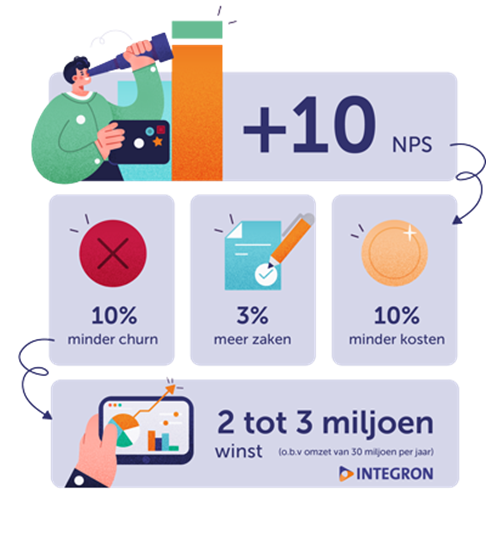Save on ‘attrition costs’ by increasing your eNPS
‘We change jobs more often’. So RTL News recently reported based on figures from the UWV. Never before have so many workers changed employers: more than 400,000 in the third quarter of 2022. A doubling compared to a decade ago. On an annual basis, the attrition rate is about 20%. Staff retention is the number-one challenge for organizations. Think of how much cost you could save if you could get this percentage down. What can you do to reduce that turnover and, in that context, how do you improve your ROI (return on investment) if you work concretely and structurally with your employee Net Promoter Score and invest in your employees?
The eNPS (employee Net Promoter Score) reflects an employee’s enthusiasm about the employer in a score. It is determined very simply, namely by answering the question of whether you would recommend your employer to others. You then subtract the people who don’t, the detractors (score 0 – 6), from the people who do, the promoters (score 9-10). The eNPS in the Netherlands is +12 (31% – 19%). An increase over the previous year. This is evident from our most recent Employee Experience surveys. These show that promoters are less likely to leave and absenteeism. As you can see from the calculation above, 31% of working Holland strongly recommend their own organization to work there, but 19% definitely do not.
Absenteeism and turnover have the greatest financial impact
A positively rising eNPS means less turnover and less absenteeism. These two issues have by far the greatest financial impact on organizations. And cause headaches not only for executives, but also for HR departments. There are gains to be made on both counts:
A higher eNPS brings down your attrition rate
The departure and subsequent replacement of employees costs a lot of money. The cost of employees changing employers is about 11,500 euros* per person. For a company with 100 employees, 20 of whom leave (again, consider that 20% turnover on an annual basis), this means 20 x 11,500 = 230,000 euros. With a high eNPS, you reduce this. For example, our research shows that as many as half (50%) of detractors start applying for jobs within 12 months. Among promoters, it is only 10%. Thus, more promoters means less turnover. There is still a huge potential here for employers. In 2022, as many as one in three employees reported that the employer could have retained them. By listening to them more and better, asking for feedback more often and acting on employee wants and needs.
A higher eNPS brings down your attrition rate. This will prevent at least 12,000 euros in costs per NON-retiring employee!
Increasing job satisfaction reduces absenteeism and costs
Absenteeism also has major financial consequences. According to CBS figures, absenteeism rose to 5 percent in the third quarter of 2022. Absenteeism was last this high in the third quarter in the 2000s and 2021s. Staff shortages and consequently higher workloads are factors in this. But things like employee job satisfaction, pride and commitment also play a role. A sick employee costs 250 to 400 euros per day. On an employee base of a thousand people, 5% absenteeism is a more than considerable cost that then runs into the millions of euros. So reducing absenteeism pays you a lot of dividends. Our latest research shows that fewer detractors within your company means less absenteeism.
Reducing absenteeism by increasing job satisfaction, pride and commitment will save you up to $400 per day per sick employee.
Thanks to more insight, working towards less absenteeism and turnover, and above all becoming an (even) finer employer
Using the eNPS to gain insight into how employees are doing is becoming more common and has many benefits. However, the challenge is not so much in measuring the eNPS, but in targeting the increase of this percentage. Based on our studies in organizations implementing a concrete Employee Experience strategy, we see that an increase of 5 to 10 percent per year is certainly possible. In short: promoters make the difference for you. They think they work at a nice company and that there is a nice, pleasant working atmosphere. They carry and radiate this, which has an enthusiastic effect and reduces turnover and absenteeism. Curious about what you can save by investing in employee experience? Calculate it with our EX ROI calculator.
Working on employee experience and rising eNPS: an ongoing process
So how do you turn detractors into promoters? And how do you make promoters stay promoters? To do this, it is necessary to know your own employees well. By regularly surveying your employees, you will know what concerns them and what you can do based on their feedback to increase their job satisfaction. Although in these times primary benefits have again become more important, investing in happy employees should certainly not be missing from your strategy. In doing so, research is not an end in itself, but helps you achieve your organizational goals. We are seeing more and more organizations conducting more frequent thematic employee surveys as part of a long-term strategy, in order to take better and faster action. Measuring the eNPS in these surveys is therefore an established and very important KPI.
*Figures are calculated based on a modal income and about 20% of the departing employee’s gross annual salary up to the first three months for induction of a replacement colleague.
Less turnover and absenteeism the result of more job happiness
Just to recap the (financial) benefits if you increase your eNPS on an ongoing basis:
- Promoters absent and leave less.
- Each prevented departure also prevents at least 12,000 euros in costs.
- eNPS can also act as a predictor; a decline may well herald a problem.

Measuring customer satisfaction is invaluable in today's competitive marketplace. Customer satisfaction surveys (KTO) provide organizations with insight into their customers' expectations and experiences. This is essential for improving customer loyalty. Integron supports companies in conducting these surveys. Thus, we not only provide valuable data but also develop complete strategies to strengthen their customer relationships. In this blog, we explain why a KTO is a strategic tool for improving your services and creating satisfied and loyal customers.
The industry continues to do well. Also in the past year, the industry was overwhelmingly on the right side of the line and, along with wholesale, has the most loyal and enthusiastic customers in B2B Netherlands.
"There are issues at play right now that take priority over collecting feedback from employees and customers. 'Too big an investment'. SME organizations are not always willing to commission employee and customer surveys. Yet fortunately, there are quite a few organizations that do collect feedback from employees and customers, see the value of it and reap the benefits. And that is more than justified. It's absolutely valuable to gain insight into what's going on and what resonates with employees and customers.




